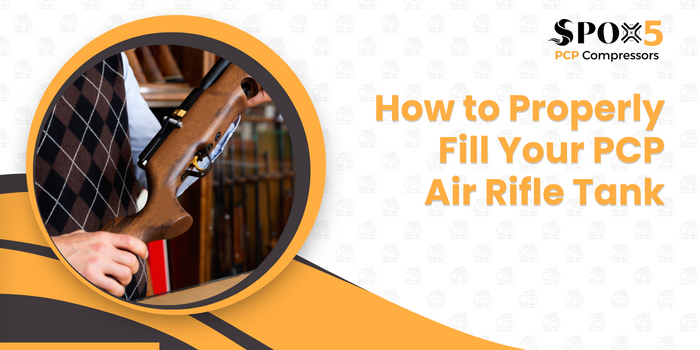PCP (pre-charged pneumatic) air rifles offer unparalleled accuracy and power, making them a favourite among target shooters and hunters alike. But unlike their traditional spring-piston counterparts, PCP air rifles require a dedicated air source to reach their full potential. Enter the SPOX5 PCP compressor, a compact and versatile solution for refilling your PCP air rifle tank at home.
This guide delves into the safe and efficient filling of your PCP air rifle tank with a SPOX5 PCP compressor. From safety precautions to step-by-step instructions, you’ll gain the knowledge and confidence to maintain your air rifle and enjoy uninterrupted shooting sessions.
Safety First: Essential Precautions
Before diving into the filling process, prioritizing safety is paramount. Here are some crucial precautions to remember:
- Read the Manuals: Thoroughly study the user manuals for both your PCP compressor and air rifle. These resources contain crucial safety information specific to your models.
- Eye Protection: Always wear ANSI-rated safety glasses while operating the compressor and handling the air rifle tank.
- Work in a Ventilated Area: PCP compressors can generate heat. Operate the compressor in a well-ventilated space to avoid inhaling fumes or excessive heat exposure.
- Know Your Limits: Never exceed the maximum fill pressure specified for your air rifle tank. Overfilling can be catastrophic and lead to serious injury or equipment damage.
- Leak Detection: Before connecting the compressor to the air rifle tank, perform a leak check on the compressor’s hoses and connections. Use a soapy water solution to identify any bubbles indicating leaks.
Preparing for Filling: Gathering the Necessary Gear
Once you’ve prioritized safety, gather the necessary equipment for a smooth filling experience:
- PCP Compressor: Ensure your compressor is in good working order and properly maintained.
- Fill Kit: Most PCP compressors come with a dedicated fill kit with a fill hose with a quick-disconnect (QD) fitting on one end and a matching adapter for your specific air rifle tank.
- Air Rifle Tank Depressurizer (Optional): If your air rifle doesn’t have a built-in depressurizer, consider purchasing a separate depressurizer to safely remove residual pressure from the tank before filling.
- Pressure Gauge (Optional): While most PCP compressors have built-in pressure gauges, having a separate pressure gauge for your air rifle tank can provide additional peace of mind.
- Safety Glasses: ANSI-rated safety glasses are non-negotiable.
- Teflon Thread Seal Tape (Optional): Some users recommend using a small amount of Teflon tape on the threads of the fill adapter for a tighter connection, but consult your air rifle and compressor manuals for specific recommendations.
Filling Your PCP Air Rifle Tank: A Step-by-Step Guide
Now that you’re prepped with safety measures and equipment, let’s walk through the filling process:
- Depressurize the Air Rifle Tank (if necessary): If your air rifle doesn’t have a built-in depressurizer, use a dedicated depressurizer to remove any residual pressure from the tank. Follow the manufacturer’s instructions for safe depressurization.
- Connect the Fill Hose: Attach the QD fitting on the fill hose to the corresponding port on your PCP compressor. Screw the adapter on the other end of the fill hose to the fill port on your air rifle tank, ensuring a snug and secure connection. Use Teflon tape sparingly if recommended by your manuals.
- Double-Check Everything: Visually inspect all connections for tightness and leaks. Ensure your safety glasses are on and the compressor is turned off.
- Power On the Compressor: Turn on the PCP compressor according to the manufacturer’s instructions.
- Monitor Pressure Levels: Pay close attention to the pressure gauges on both the compressor and (if used) your air rifle tank.
- Fill to the Recommended Pressure: Gradually fill the air rifle tank to the pressure specified in your air rifle’s user manual. Never exceed the maximum fill pressure.
- Stop the Filling Process: Once the desired pressure is reached, turn off the PCP compressor and disconnect the fill hose.
Additional Tips for a Smooth Filling Experience:
- Start with a Cool Tank: A cooler air rifle tank allows for a more efficient fill and reduces the risk of exceeding the pressure limit due to heat expansion.
- Fill Slowly: Avoid rapidly filling the tank. A gradual fill allows for better temperature regulation and prevents potential damage to the tank.
- Listen for Leaks: Be attentive to hissing sounds that might indicate leaks during the filling process. If you detect a leak, immediately stop the compressor, disconnect the hose, and troubleshoot the issue.
- Maintain Your Equipment: Regular maintenance of both your PCP compressor and air rifle tank is crucial. Follow the manufacturer’s recommended maintenance schedule for each piece of equipment to ensure optimal performance and safety.
- Keep Records: It’s helpful to maintain a logbook where you record the date, fill pressure, and any observations you make during each fill session. This information can be valuable for troubleshooting any future issues and monitoring the overall health of your air rifle tank.
Conclusion
By following these guidelines and prioritizing safety, you can confidently and efficiently refill your PCP air rifle tank using your SPOX5 PCP compressor. This empowers you to maintain your air rifle for extended shooting sessions, allowing you to enjoy the power and precision it offers. Remember, if you’re unsure about any aspect of the filling process, consult your air rifle and compressor manuals or seek guidance from a qualified professional.
Happy Shooting!

